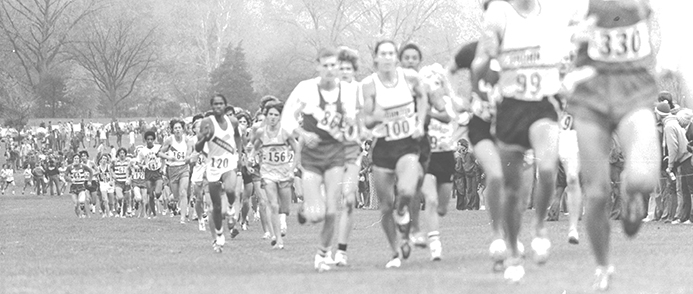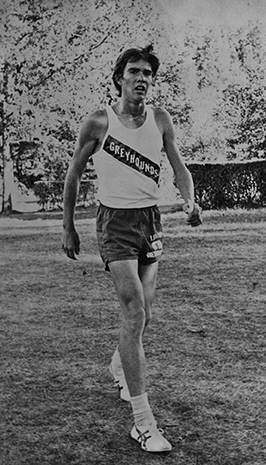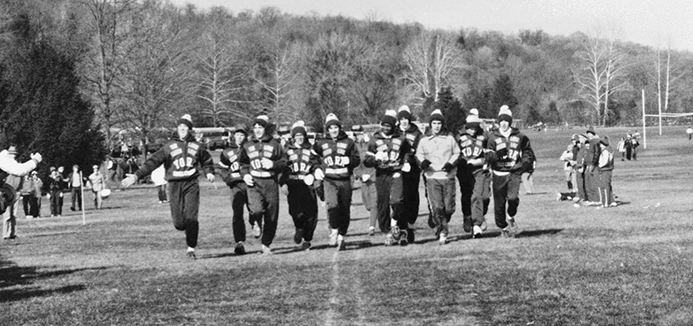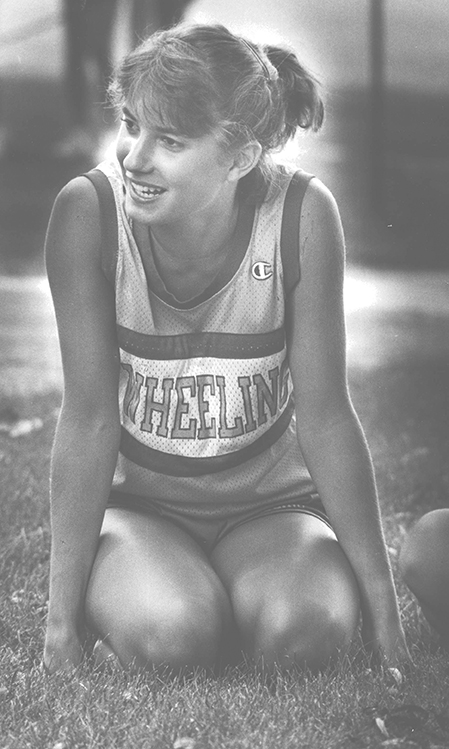
During his award-winning career at the Peoria Journal Star, Kirk Wessler covered every aspect of the IHSA Cross Country State Finals in Peoria. Kirk took on the monumental task of recapping the past 50 years of the state meet at Detweiller:
50 Years of Running In Peoria
If anyone tries to tell you cross country is not a spectator sport, invite them to the IHSA state championship races at Peoria’s Detweiller Park.
Between 10,000 and 15,000 fans are expected to churn through Detweiller this weekend for the six races that will determine the 2019 state champions in three classes of boys and girls competition. They’ll come by cars, SUVs and buses, filled with family and friends, cheerleaders and pep ensembles, young and old, college recruiters and running enthusiasts.
They will ring both loops that form the three-mile race course, lining both sides of the well-worn path. Many will stake out a spot from which much of the race can be seen. Many others will jog back and forth across the infield of the bigger loop to double their up-close viewing pleasure – and still be able to see most of the race unfold.
It is a singular experience that, combined with the extraordinary quality of Illinois high school distance running, has made the IHSA state championships and Detweiller Park nationally famous.
This weekend marks the 50th successive year the state championships have been hosted by Peoria High School at Detweiller. Over those 50 years, this event and venue set and raised the bar for what an elite cross country meet could be for participants and spectators alike.
What you see today began with the vision of a few key people, grew with the enthusiastic support and hard work of thousands of volunteers, and blossomed into a full-blown treasure with the endearing – and enduring – performances of the young runners.
We celebrate all of them. But we can’t let a golden anniversary pass without sharing a few of the key stories that built the event and made it what it is today.
THE RECORD
The elite quality of the IHSA cross country championship at Detweiller is proven with one fact: Every Summer Olympics since 1976 has included at least one alumnus of this event.
(See the list below)
But it is probable that no single performance in any Illinois sport is more iconic, more revered or more sacred than the Detweiller course record of 13:50.6. It has loomed over this event for almost half a century.

Craig Virgin
(right), who would become a three-time U.S. Olympian and the only American to win a world cross country championship, set the mark in 1972, the third year the meet was in Peoria.
But that record is actually rooted in the Detweiller state inaugural, in 1970. Virgin was a sophomore at tiny Lebanon High School, and he came here to try to chase down defending champion Dave Merrick of New Lenox Lincoln-Way. Merrick was considered the best high school distance runner in the nation, and Virgin would hang on his shoulder to the midpoint of the race, at which point Merrick shifted into another gear and ran away.
“My philosophy was to go out hard, then put the hammer down in mid-race and say, ‘Who wants it?’” Merrick says.
Virgin faded to a sixth-place finish in the single-class race. Frustrated, he sought out Merrick for advice. Merrick was happy to share and spelled it out: Run every single day; never take a day off. Run in the morning before school. You don’t have to pound it, but you must build a foundation of unrivaled endurance that allows you to drop that hammer on anyone who challenges you.
“For Craig, that was like money in the bank,” Merrick says. “He got it.”
A year later, the distance of the course was increased from 2.67 miles to three miles, where it has remained.
As a junior in 1971, Virgin breezed through the new layout in 13:59, leaping across the finish line and thrusting his arms skyward.
Then came 1972. Virgin had been on a mission to set the course record wherever he competed. That usually meant breaking a mark he had set the previous year. Detweiller would prove no exception, and nobody had a prayer of staying with him.
On a sunny morning, with temperatures in the mid-40s, Virgin dropped the hammer immediately, sprinting to the lead and cruising through the first mile in 4:25 with a smile on his face. The crowd roared. A 4:25 opening mile? Who does that? Who would think of doing that?
Virgin passed the two-mile post in 9:16, then accelerated to a 4:35 final mile to cross the finish line 30 seconds ahead of second place. The crowd knew it had witnessed something special. But nobody could have imagined how special, partly because the first assault on Virgin’s mark would take place the very next season.
While Merrick had greatly influenced Virgin’s career with one chat, Dave Walters absorbed everything Merrick said and did on an almost daily basis. They had been Lincoln-Way teammates when Walters was a sophomore.
“Walt was a sponge,” Merrick says. “Walt maxes out everything he has. He drops the hammer all the time.”
Walters was injured as a junior and did not run state when Virgin set the record. Determined to make up for lost time, he decided in June 1973 that he would do everything necessary to win the state championship that fall. He spent the summer training with Merrick, stride for stride.
“Dave taught me how to never back down, how to embrace pain,” Walters says.
One more thing. From June onward, Walters ran the state meet in his mind. “Every single day,” he says.
At the state meet, Walters remembers slowing briefly to catch his breath after the first climb up the 7% grade along the park road, about three-quarters of a mile into the race. A rival passed him and slapped him back into reality. He pursued the lead pack down Route 29, then into the smaller loop, known as the “triangle,” where so many huge moves have determined race outcomes. He surged to the lead and, to his astonishment, nobody went with him.
But Walters, who lacked the speed of a great kicker, refused to look back. He just kept dropping one hammer after another on the field. With a half-mile to go, as he headed to the horseshoe turn at the bottom of the park road for the final time, he saw the legendary Elmhurst York coach Joe Newton.
“Relax, Dave! You got this thing won,” Newton barked.
Walters wouldn’t believe it and kept pushing until he had crossed the finish line as champion. He shocked himself with his 13:57. His chief rival, Bill Fritz of Glen Ellyn Glenbard West, finished nine seconds later, having closed the gap considerably during a furious uphill kick. But by then, Walters had hit Fritz with too many hammers.
In 1977, Tom Graves of Orland Park Sandburg clocked 13:56 to outduel future Olympian Jim Spivey by four seconds for the Class AA crown. (The first two-class championship had been contested the previous year.)
But it would be 21 years before a runner touched 14:00 again – this by future Olympian Jorge Torres of Wheeling. Another eight years passed before the 14-minute barrier was broken again and Virgin’s record withstood two serious assaults.
The first came from Chris Derrick of Naperville Neuqua Valley in 2007. Like Walters, Derrick at the time was considered a championship contender, but not a record threat. Nor was he talking smack.
“I’m always looking for runners whose performances show they have what it takes,” Virgin says.
Virgin still attends the meet most years. If his record falls, he wants to witness it and congratulate the conqueror. He was there when Derrick won, but he wasn’t paying close attention to the splits and had no idea how imperiled the record had been until a friend told him the winning time was 13:52.
Likewise, Virgin is always aware of runners who say their goal is to take him down. He enjoys that. It’s the kind of bravado he had as a runner, and it’s a trait he takes seriously. So, when in 2010, Lukas Verzbicus of Orland Park Sandburg announced his intentions, Virgin believed the threat was serious.
Verzbicus was no pretender. He had strong bloodlines, and the way cross country had evolved, with elite national and international competitions available to high school stars, Verzbicus also harbored bigger dreams.
Virgin talked his way onto the pace truck, where he could watch alongside the film crew and live commentators. It was a perfect day, with early afternoon temperatures around 50 and not a hint of wind. It turned into a rollercoaster for Virgin and the crowd as Verzbicus mounted his assault.
When Verzbicus took 4:30 to cover the first mile, many thought he had started too slow. But when he nailed the second mile in 4:40 to sail through the two-mile mark at 9:10, Virgin started preparing his public remarks on seeing the record fall. But suddenly, in the final quarter-mile, a light breeze kicked out of the south and directly into the runners’ faces. Verzbicus finished in 13:54. Frustrated, he said the course was “cursed.”
“I was still on pace, but then a gust came over me,” Verzbicus told reporters after the race. “It was like Virgin was holding the course under his fist.”
So, what will it take to break this record – besides talent and guts?
“It takes a hard first mile,” Virgin says. “Then you have to recover in the second mile. You can’t let up too much, but you have to recover because remember, the last mile has two uphill grades. They’re not much (just 7%), but over 600 yards, they get to you.
“You have to plan like an Indy car driver who finishes on his last drops of fuel. And you cannot have a moment of hesitation or second-guessing, or you’ll come up short.”
That’s all, huh?
 THE DYNASTY
THE DYNASTY
Before anyone had heard of Craig Virgin, and before the IHSA even contemplated moving the state meet from Savoy, cross country runners of all ages were aware of the “Long Green Line” at Elmhurst York.
During the 1960s, the green-uniformed Dukes won three state championships. Then they really got good.
From 1971-2012, a period of 42 years, York won 25 boys championships in single class, AA or 3A. In the other 17 seasons, the Dukes finished second 10 times, third once and – get this – never finished outside the top five. The Dukes put together championship streaks of six, five (twice) and three. From 1980-94, they won 12 of 15 times.
They did it first by taking the art of pack running to a higher level, with potential stars sacrificing themselves to help less talented teammates run better than they ever imagined. And they sustained the team excellence because their coach was a pied piper who each year talked dozens of boys into running and always found at least seven who were talented and tough enough to be really good.
That coach was Joe Newton.
“Coach Newton didn’t invent cross country, but he made it what it is,” Mike Garcia says. “The impact he had on cross country, on his runners, on other coaches, on the state meet … it’s amazing how one man had that much influence. Cross country in Illinois would not be what it is today without Coach Newton.”
Garcia’s insight comes from three perspectives few have been privileged to experience. He ran for Newton in the 1970s, was Newton’s assistant coach in 1989-90, and he coached against Newton and York at both Chicago Mendel Catholic and Springfield Lanphier, where he remains today.
Newton was tough, demanding, decidedly old-school in demeanor. He was a demon for detail and discipline. His runners wore Marine-style haircuts, buzzed just millimeters from the bare scalp. Sometimes that hairstyle was in, and sometimes it was totally out. But no matter the era, boys who went to York wanted to run for Joe Newton; team membership running as high as 150 some years.
“He was a master psychologist. He made you believe without doubt,” Garcia says. “His ultimate goal was to make you a better person, a better runner and to get the most out of you – not just the seven who ran in the state meet, but all 150 on the team. He was always there for us. He would go above and beyond for everyone.”
Newton thirsted for every shred of extra knowledge he could find in his quest to make his runners and teams better. He sought out Sebastian Coe, the Olympic champion from Great Britain, for guidance on new workouts. He invited world-class runners from Finland to visit Elmhurst to show his kids the proper way to do fartlek training.
No surprise, Newton also was nearly maniacal about preparation. He left nothing to chance. When York arrived in Peoria on the Friday before the state meet, Newton had the itinerary – from arrival to dinner, lights out to breakfast, drive from the hotel to Detweiller – planned “to the minute,” Garcia says. Warmups, he adds, were planned “to the second.”
It all paid off in a level of domination that was sustained through six decades. Other teams won, of course. Sometimes. Chicago Heights Bloom and Deerfield kept York out of the winner’s circle for four years in the mid-1970s, Schaumburg won three times in four years during the period York won 12 of 15. And in smaller classes, Elmwood and Eureka have won several championships.
But no team could touch what York ran out there, year after year after year.
All because of one coach.
“Coach Newton made it where the cross country runners at York were treated with the same respect as the football players. Not more, but the same,” Garcia says. “He believed cross country should be a spectator sport – and look what it has become.”
THE GIRLS
As large as Craig Virgin and the Joe Newton/York dynasty loom, casting their historical certainties over the boys state meet, the girls championships have provided a wild ride of endless possibilities.
The first girls state meet was contested in 1979, the 10th year at Detweiller, and immediately started creating heroines and standard-bearing programs of their own – although the team torch gets passed around a lot more than what we’ve seen with the boys.
Wheeling won the first championship – and four of the first nine. Palatine would take over the big schools at the start of the two-class era, winning four in a row from 1989-92, and Winnebago would become the small-school program to beat, winning 12 championships (more than any girls team in any class), including a record five in a row from 2005-09. And in the current decade, 3A Naperville North has become the team to beat in any class, winning five of its nine overall championships since 2012, including a live streak of three.
But the real fun has been watching the individual battles and how fast the course records fall.

The girls have given us three four-time champions, a feat no boy has ever accomplished. Dana Miroballi
(right) of Wheeling was the first, and when she finished her career sweep with the course record in 1987, the crowd roared her name as she kicked up the park road to the finish: “Da-na! Da-na! Da-na!”
Nearly two decades later, Katelyn Bastert of Carthage would follow with four Class A titles from 2003-06. Then there was Anna Sophia Keller of Effingham St. Anthony, grabbing four Class 1A crowns from 2013-16.
A fourth could join them this weekend. We’ll get to her in a moment.
The boys course record at Detweiller has been set three times – but not at all since 1972. By comparison, the girls course record has been set and reset 15 times in 40 years. And in the 17 years running three miles, the girls have set seven course records.
“The women’s progressions have been remarkable,” says Philip Lockwood.
Lockwood is the color commentator for IHSA TV broadcast of the races, the audio for which is fed over the PA system in real time for those thousands of spectators. He presides over Peoria’s world-famous Steamboat Classic road run each summer, and he is involved internationally with race timing technology.
For the first 19 years, the girls ran only two miles. A four-year transition period at 2.5 miles followed. Then in 2002, girls started running the same three-mile course as the boys.
That first year at three miles, the top girls time was 17:10, by Samantha Polock of Wheaten North. But while boys times overall have remained largely static, there seems to be no limit yet on what the girls are capable of accomplishing. Every two or three years, it seems, another 10, 15 or even 20 seconds get chopped off the all-time girls mark.
Judy Pendergast of Naperville North set the current record in 2015, crashing through the 16-minute barrier and timing 15:54.
The next year, freshman Katelynne Hart of Glen Ellyn Glenbard West won her first Class 3A championship in 16:31. She won her next two titles in 16:22 and 15:59 and comes to Detweiller this weekend positioned to join the four-champ club and break the course record.
How fast can the girls go?
“It wasn’t too long ago that girls were running only two miles, so there’s lots of room to grow,” Hart says.
She ran 16 minutes flat at the Richard Spring Invitational in September and is confident of her ability to smash Pendergast’s mark – even if she says that’s not her goal. If Hart has a standard in her mind, she’s not sharing it with the public.
But Hart does have an idea what the possibilities are.
“We’ve got girls under 10 minutes for two miles,” she says. “So I can definitely see times getting to the mid-15s for three.”
Virgin goes so far as to offer a prediction.
“Watch Katelynne Hart,” he says. “I think we have a chance this year to see her run that iconic girls time.”
THE COURSE
Along the park road through lower Detweiller Park, just two steps of the race course and 50 yards from the finish line, a giant boulder rests in the grass. The plaque on the boulder commemorates the contributions of Bob LaCroix to the IHSA state cross country championships.
LaCroix was the head cross country coach at Peoria High School when IHSA officials approached school administration about the possibility of hosting the state meet. Peoria High in the 1960s had begun staging a 44-team invitational the first Saturday of October, and among the influential people who was impressed by both the course and the organization was Joe Newton of York.
Peoria High principal Harry Whitaker, athletics director Corky Robertson and former cross country coach Neil Wicker – along with a volunteer force of faculty and community that has swelled into the hundreds – all jumped in to help make it happen.
LaCroix was the perfect combination of leadership and elbow grease; organizing, directing, chalking the main line of the course with his team manager Marc Russell, erecting snow fencing and double- and triple-checking to make sure every detail was taken care of.
“Detweiller is sacred ground, Mecca for Midwestern cross country, and Bob LaCroix was the genius 50 years ago who was responsible for this,” Virgin says.
In 1970, the course measured 2.67 miles, and the starting line was at the bottom of the big loop. The distance would be increased to three miles the next year, with LaCroix precisely measuring from point to point and burying empty soup cans in the ground to make sure the course was exactly marked each subsequent year.
There have been minor alterations to the course since then.
The starting line was pushed a short distance down the middle of the big loop to better accommodate pre-race staging and spectators. That necessitated adding distance in the smaller loop that covers about one-half mile in the middle of the race.
That small loop originally formed an almost perfect triangle from the bridge to the northeast corner of the course to the northwest corner and back to the bridge. The alteration turned the triangle into more of a rectangle, although many still call it “the triangle.” A smaller tweak occurred when a second bridge was built next to the first one.
But the historic competitive integrity of the course has remained constant.
The biggest thing the move to three miles did was to render Dave Merrick almost a forgotten man.
“I wish I had been able to compete on the three-mile course, if only to compare myself to what others have done there,” Merrick says. “Craig would still be the benchmark, regardless. He was phenomenal. But still, it’s neat to know that I was at the front of a wave of great runners there that continues on.”
Merrick’s time of 12:37.6 for the 2.67-mile distance converts roughly to a 14:12 for three miles. But the starting line was adjacent to the horseshoe and the first 600 yards were raced uphill, as opposed to downhill. Tactics were different. And everyone who ran against him scoffs at the notion that Merrick would not have broken 14 minutes on the current course; the only question is by how much.
Over half a century, hundreds of thousands of spectators have trekked to the north Peoria park in early November to watch memorable running performances. Detweiller always seems to deliver something memorable, whether it’s a future Olympian or an early snow; a course record on a perfect day or a muddy slog in blinding rain.
Who could ever forget being there in 1972 for Craig Virgin’s record-setting race? Or the epic, elbow-to-elbow, start-to-finish battle between champion Alana Crisman of Rushville and runnerup Stacy Sullivan of Petersburg PORTA in the 1996 Class A girls race, which was decided by less than one second? Or Lukas Verzbicus’ agony over barely falling short of Virgin’s mark? Or Joe Newton lamenting one of those rare non-championship races by acknowledging, “I’ve created a monster”?
Or this? Eureka’s boys won the 1999 Class A team title with the ridiculously low score of 32 points, accomplished with times which, when imposed on the Class AA race that day were outdone by only one team in the entire state, regardless of class – that, of course, being York, with a dual-meet worthy 24 points.
A decade into the state Detweiller experience, LaCroix left Peoria High to coach his own kids at Peoria Richwoods and his organizational duties were reassigned. But he kept coming back to the meet, and he hasn’t missed a single one.
These days, you’ll find him in charge of crowd control around the media and coaches bullpen area near the finish chute. He usually has a smile on his face. And why not?
“The growth of this meet to what it is today,” LaCroix says, “is just mind-boggling.”
INFO FOR OLYMPIANS BOX
1976 Montreal: Mike Durkin (Holy Cross), Craig Virgin (Lebanon)
1980 Moscow: Mike Durkin (Holy Cross), Craig Virgin (Lebanon) *
1984 Los Angeles: Jim Spivey (Fenton), Craig Virgin (Lebanon)
1988 Seoul: Mark Deady (Stevenson)
1992 Barcelona: Jim Spivey (Fenton)
1996 Atlanta: Jenny Spangler (Guilford), Jim Spivey (Fenton)
2000 Sydney: Marius Bakken (York)
2004 Athens: Tim Broe (East Peoria), Anne Gaffigan (Sacred Heart-Griffin), Marrius Bakken (York)
2008 Beijing: Jorge Torres (Wheeling), Christin Wurth-Thomas (Bloomington)
2012 London: Evan Jager (Jacobs)
2016 Rio de Janeiro: Evan Jager (Jacobs)
*-The USA boycotted the 1980 Olympics, but athletes who qualified for the team are still considered Olympians.